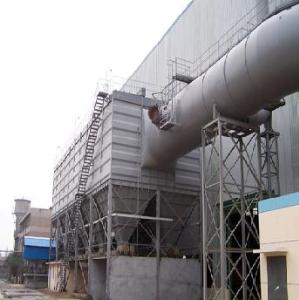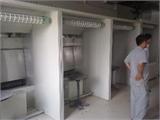Waste gas dust removal in environmental protection equipment
Summary of Environmental Protection Equipment - Exhaust Purification and Dust Removal
Environmental protection equipment for exhaust purification and dust removal includes (dry, wet), spray booths, activated carbon exhaust purification equipment, paint mist purifiers, catalytic combustion exhaust treatment, various dust collectors, etc.
Catalog 123456
1. The LFT series activated carbon exhaust purifier is a dry industrial exhaust treatment device developed using the extremely special adsorption effect of activated carbon. The device mainly consists of activated carbon adsorption units installed inside the box body, with inspection ports for daily maintenance and exhaust inlets and outlets on the box.
2. The LFT type activated carbon exhaust purifier is easy to install and can be designed according to the actual site conditions of customers. Generally, ducts are used to guide the exhaust gas to the inlet of the equipment, the outlet of the equipment is connected to the inlet of the fan, and the purified air is discharged into the atmosphere through the duct at the outlet of the exhaust fan.
3. The core component of the LFT type activated carbon exhaust purifier is the drawer-type adsorption unit, which has the characteristics of low ventilation resistance, convenient replacement, and standardized design. Moreover, it can ensure that the ventilation resistance remains stable throughout the entire usage cycle (i.e., does not change due to changes in the status of the adsorption unit).
4. Different fillers in the LFT type activated carbon exhaust purifier can handle various types of exhaust gases: organic exhaust gases and odors (such as benzene, phenols, alcohols, ethers, ketones, etc.), acidic exhaust gases and acid mists (for example: NO2, H2SO4, HCL, HF, etc.), alkaline exhaust gases (for example: NH3, etc.). Organic exhaust gases with concentrations below 1000mg/m3 can meet the requirements of GB16297-1996 "Comprehensive Emission Standards for Atmospheric Pollutants" after being treated by the purifier.
5. The application fields of the LFT type activated carbon exhaust purifier are extremely extensive, including electronic component production, acid washing operations, metallurgical chemical industries, coating industries, battery (accumulator) production, laboratory exhaust, chemical plants, pharmaceutical production plants, food and brewing, furniture production, printing, ink, paint, light industry, synthetic leather processing, rubber plastic processes, cathode ray tube production, and other industries where organic solvents and malodorous exhaust gases are produced during production.
6. The LFT type activated carbon exhaust purifier can also be used in conjunction with spray booths, drying rooms, and spray booths to treat organic exhaust gases generated during spraying and drying processes.
7. The adsorbent used in the LFT type activated carbon exhaust purifier adopts newly developed composite adsorption technology activated carbon. This activated carbon combines physical and chemical adsorption. According to the different main components of the exhaust gas, the activated carbon undergoes special pretreatment. Honeycomb-shaped activated carbon with small wind resistance and large specific surface area can achieve efficient physical adsorption. Special chemical components on the activated carbon react with pollutants, generating solid components or harmless gases. Chemical adsorption can thoroughly remove pollution. The combined action of physical and chemical adsorption greatly improves the utilization efficiency of activated carbon, doubling the life of ordinary physically adsorbed activated carbon. The main advantages of the LFT type activated carbon exhaust purifier: high adsorption efficiency, low operating cost, easy maintenance, and the ability to handle multiple mixed exhaust gases simultaneously.
The LFBC series pulse bag dust collector uses a pulse spray cleaning method, featuring good ash cleaning results, high purification efficiency, large air volume handling, long filter bag life, low maintenance workload, and safe reliable operation. It is widely used in metallurgy, construction, machinery, chemicals, casting, tobacco, asphalt, cement, grain, boilers, and other industries. It is suitable for exhaust purification and material recovery in industrial kilns in mines, refractory materials industries, power plants, metallurgy, and carbon black industries, such as cement rotary kilns, boilers, coolers, dryers, power station boilers, lime kilns, metallurgical sintering machines, and electric arc furnaces. It is also applicable to dust collection systems (or dust removal systems) in cement factories such as crushing, drying, coal grinding, powder selection, packaging, silo tops, clinker coolers, etc. It can also be used for coal grinding dust collection but requires additional fire prevention and explosion-proof measures, with corresponding changes to the structure of the dust collector. It can also be used for dust collection in extremely high dust concentration gases, such as coal grinding systems with O-Sepa powder selectors, where gas dust concentrations reach over 1000g/m3 (standard). Pre-dust collectors like cyclone dust collectors may not be required. For cold regions in northern China, this dust collector can still be used after adding thermal insulation devices. Various industrial enterprises use pulse bag dust collectors for non-fibrous dust removal and purification, separating particles and fine dust from industrial exhaust gases, turning waste into treasure for recycling purposes.
Dusty gases enter the filter through the inlet, and larger dust particles fall directly into the ash hopper due to inertia; dusty gases pass through the filter bag, and dust is retained on the surface of the fabric bag. The purified air enters the upper chamber from inside the filter bag, then passes through the filter bag outlet, valve plate hole to the static pressure room, and is discharged into the atmosphere by the exhaust fan, thus achieving the purpose of dust removal. As filtration continues, the resistance of the dust collector increases. When the resistance reaches a certain value, the cleaning controller issues a cleaning command, first closing the lifting valve to cut off the filtering airflow, then the cleaning controller sends a signal to the pulse solenoid valve, and the pulse valve sends high-pressure air used for cleaning into the bag, causing the filter bag to quickly expand and produce strong vibrations, causing the dust outside the filter bag to fall off, achieving the purpose of cleaning. The pulse spray system cleans each filter bag in a certain order. Dust is discharged from the bottom of the device through an electric unloading ash valve into a dust collection bucket (cart).
The LFBC type bag dust collector is constructed of five parts: upper, middle, and lower chambers, ash discharge system, and spray system. The upper chamber includes a liftable cover and an air inlet, the middle chamber contains a multi-hole plate, filter bag frame, filter bag, and the lower chamber is composed of an ash hopper, air inlet, and inspection door. The spray system includes a pulse control instrument, pulse valve, spray pipe, and air tank. The pulse bag dust collector is divided into four series based on the number of bags: 32 bags/room, 64 bags/room, 96 bags/room, and 128 bags/room. Each series is further divided into various specifications based on the number of rooms.
(1) Shell part: Includes the clean room (or called gas purification box), filter room, compartment partition, inspection door, and shell structure. The clean room contains a lift valve and flower plate, spray short pipe; the filter room contains filters and their frames.
(2) Ash hopper and ash discharge mechanism: Includes an ash hopper and, depending on the series and the concentration of incoming dust, a screw conveyor, pneumatic conveying inclined chute, and rigid vane feeder (ash discharge valve).
(3) Inlet and outlet air box: Includes inlet and outlet pipelines and intermediate partition. A single row (or single column) structure is arranged on one side of the shell, while a double row (or called double column) structure is arranged in the center of the shell; for the 32 series, which is smaller, there is no box body, and the inlet and outlet pipelines are respectively connected to the ash hopper and clean room.
(4) Pulse cleaning device: Includes pulse valves, air tanks, cylinders for lift valves, and their electromagnetic valves.
(5) Compressed air piping and pressure reduction devices, oil-water separators, oil misters, etc.
(6) Pillars and vertical cage ladders, railings.
1. This equipment uses a pulse reverse blow cleaning method, which is currently the best cleaning effect in China. The upper chamber of the equipment is divided into eighteen mutually isolated small chambers, and communicates with a long venturi tube. Pulse control is used to achieve the cleaning purpose. In terms of structure, the spray pipe and the small venturi tube at the top of the filter bag have been eliminated, making the structure simple and easy to operate and maintain.
2. Compared with other domestic dust collectors, this equipment has the characteristics of large air volume processing and low system resistance, and has a wide range of applications (purification and recovery treatment of mixed gases at normal temperature, high temperature with dust concentration <60g/m3).
3. The edges of the flower plates separating the upper and middle chambers are pressed into a certain conical shape, allowing smooth contact between them and the filter bag, ensuring good sealing and reducing wear between the hole edges and the filter bag.
4. The structure is simple and reasonable, occupying a small area, and can be installed indoors or outdoors.
1. Selection of filtration velocity:
Filtration velocity refers to the velocity of air passing through the filter bag material (m/min). Some call it the air-to-cloth ratio, which refers to the amount of air passing through per unit time and per unit area of filter material, i.e., m3/min/m2, or m/min. The selection of filtration velocity must take into account the characteristics of the filtered medium, dust, and flue gas, as well as temperature and humidity, dust concentration, cleaning method, and the nature of the selected filter material. Filtration velocity not only determines the size of the dust collector but also significantly affects the resistance through the filter material, dust collection efficiency, and cleaning effect. To ensure the cleaning effect of the dust collector, improve the service life of the filter bag, and reduce resistance, the filtration velocity of this dust collector is generally 1.2 m/min. For the main dust source points in cement plants using this dust collector, it is recommended to adopt the net filtration velocity according to Table 1.
Net filtration velocity refers to the filtration velocity m/min under the filtration area when one room of the dust collector stops blowing and cleaning, and the original airflow passes through the filtration areas of other rooms.
2. Calculation of filtration area:
The following formula is used:
AN = Q / 60VN, m2
Where: AN -- net filtration area m2, referring to the sum of the filtration areas of all other rooms when one room of a particular dust collector stops blowing and cleaning;
Q -- the filtration air volume passing through the dust collector, also known as the processed gas volume m3/h;
VN -- net filtration velocity, m/min
3. Operating temperature and selection of filter material
Operating temperature is closely related to the selection of filter material. Different filter materials allow different entry temperatures for dusty gases. This dust collector generally uses polyester needle felt, with a continuous allowable operating temperature ≤120℃. When using aramid needle felt (Nomex), the maximum allowable operating temperature is 200℃. When using P84 needle felt, the allowable temperature is 260℃. If the gas exceeds the usable temperature of each filter material, cooling measures should be taken before entering the dust collector, and the filter bags can be treated for oilproofing, waterproofing, anti-sticking, and anti-static.
4. Allowable inlet concentration
Due to the special structure of this dust collector, offline pulse jet cleaning is used, so its allowable inlet concentration is higher than traditional online pulse jet cleaning and other general compartmentalized reverse blowing cleaning dust collectors. For the 32 series (small type) of this dust collector, the allowable inlet gas dust concentration is 200g/m3 (standard), and for the other 64, 96, 128 series, it can reach up to 1000g/m3 (standard). The outlet gas dust concentration of the dust collector is ≤100mg/m3 (standard).
1. Gas cleaning: Gas cleaning removes accumulated dust on the filter bag by using high-pressure gas or external atmospheric back-blowing. Gas cleaning includes pulse jet cleaning, reverse blowing cleaning, and reverse suction cleaning.
2. Mechanical shaking cleaning: Divided into top shaking cleaning and mid-shaking cleaning (both for filter bags), it uses mechanical shaking devices to periodically shake each row of filter bags to remove accumulated dust.
3. Manual tapping: Manually tap each filter bag to remove accumulated dust.
(1) Low dust concentration emissions, generally below 50mg/Nm3, and sometimes less than 20mg/Nm3. For low-sulfur coal and high-ash coal, it is very difficult for electrostatic precipitators to achieve such low concentrations, or more investment is needed (i.e., expanding from the conventional 3-field to 4-6 fields).
(2) The emission concentration is unaffected by the resistivity, concentration, particle size, etc., of the dust. Changes in boiler load and fluctuations in flue gas volume have little impact on the emission concentration at the outlet of the baghouse.
(3) Baghouses usually adopt compartment structures and leave margins in design. The compartments can be alternately inspected without affecting the operation of the boiler. Therefore, the impact on the availability of boiler equipment is close to zero.
(4) Since baghouses capture fine dust more effectively, they remove more rare metal particles contained in the fly ash than electrostatic precipitators do, and can effectively remove PM10, PM2.5 fine dust, reducing harm to the health of surrounding populations.
(5) The structure and maintenance of baghouses are relatively simple.
(6) As a key issue for baghouses—the filter material—there have been breakthroughs, with a general lifespan of more than 2 years, and some reaching 4-6 years in practice.
(7) In dry and semi-dry desulfurization systems, they further reduce the SO2 content in flue gas.
(8) It is necessary to maintain and operate the baghouse correctly.
(9) In cases such as boiler ignition and shutdown, the baghouse must be started and shut down strictly according to the correct operating procedures.
(10) It is necessary to control the flue gas temperature within the range that the filter material can withstand, and it should not be lower than the acid dew point.
(11) The loss is greater than that of electrostatic precipitators, generally around 1200~1800Pa.




